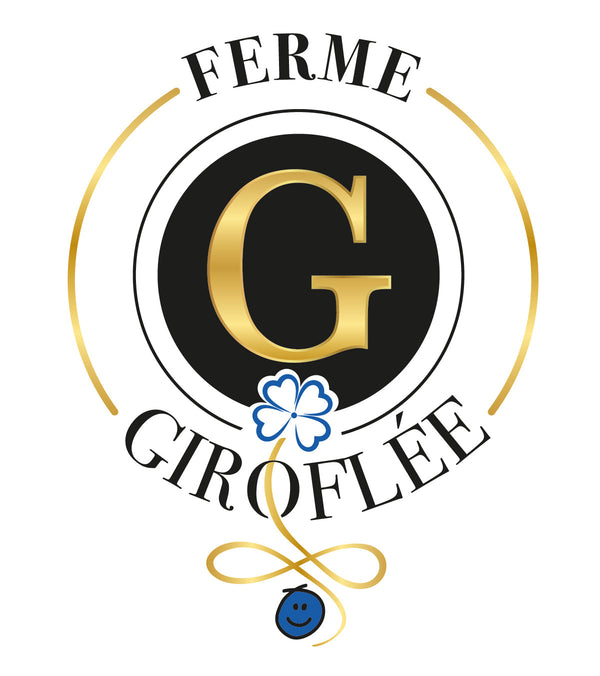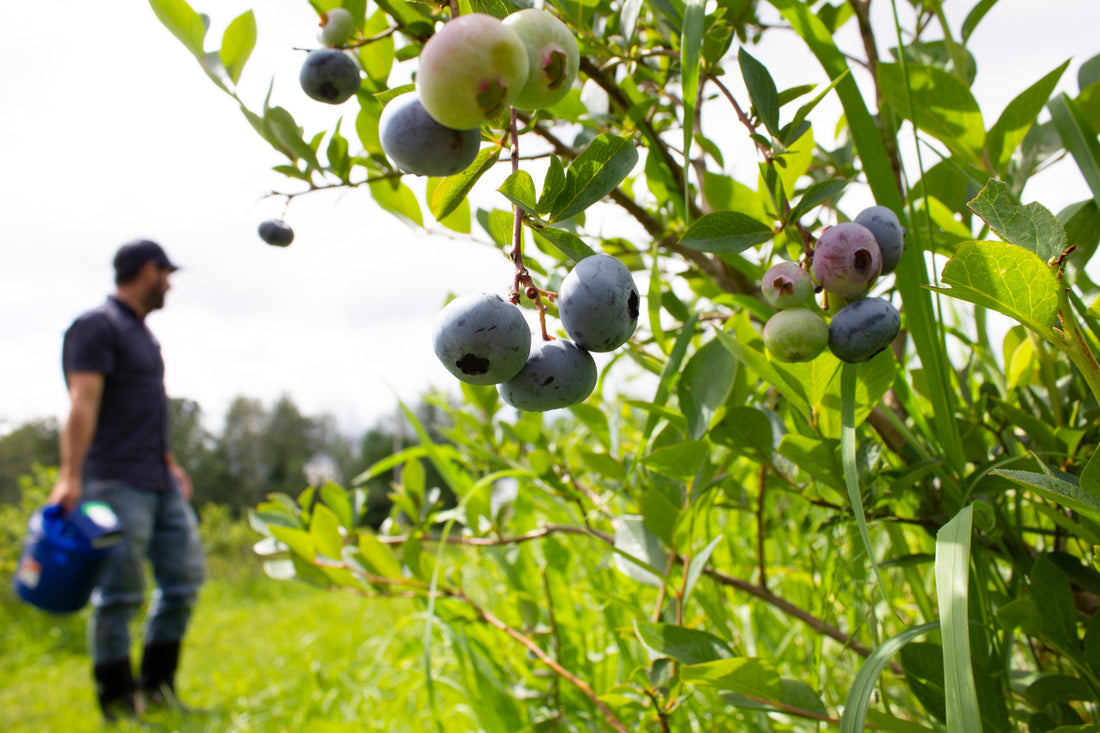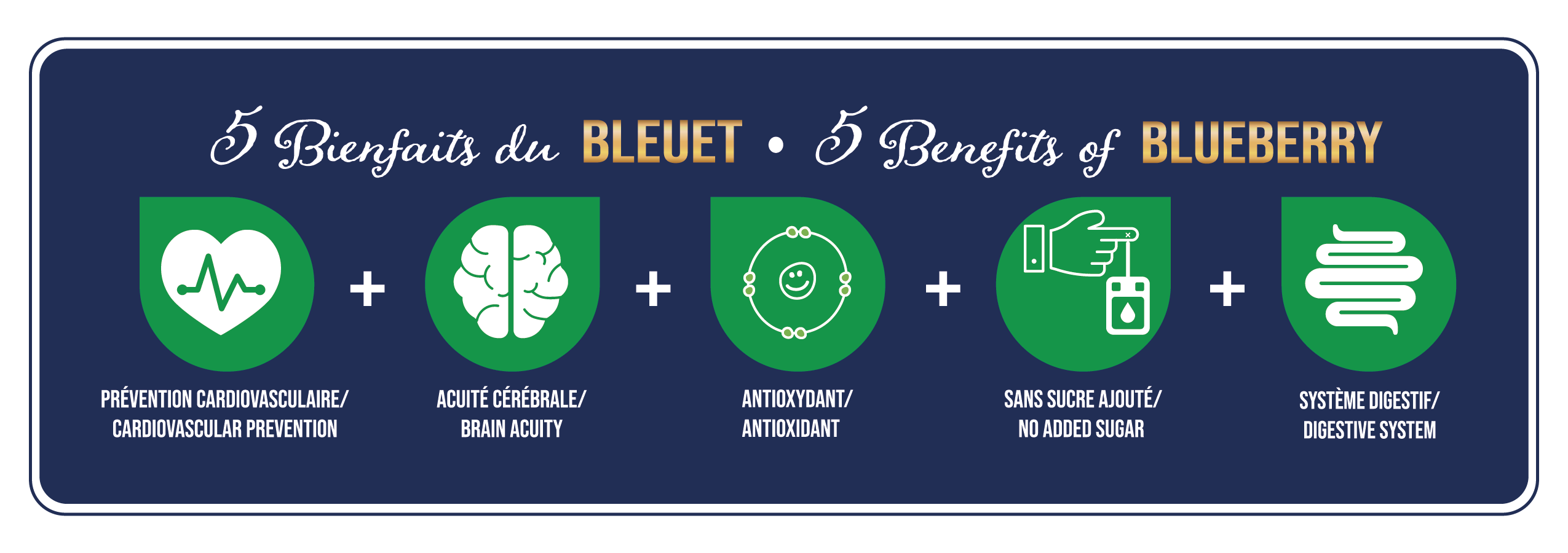Written by Mariklôde Tardi
The highbush blueberry, Vaccinium corymbosum in Latin, is of course an interesting species for its flavors, textures and the size of its fruits. But what about its health benefits? And can growing conditions influence the nutritional value of this little fruit? To find out more, let's see what the results of some research tell us.
Blue-black pigments and polyphenols
Researchers around the world have looked into this iconic blue berry from Quebec and found that the blueberry's distinctive blue-black pigments are packed with health-promoting bioactive compounds. These pigments come from the presence of anthocyanins, a polyphenolic flavonoid in large quantities in this small fruit.
Polyphenols are antioxidants that protect the body against free radicals, unstable molecules that damage cells and increase the risk of chronic and degenerative diseases (Hoelzl, C. et al., 2005).

During a study carried out at Laval University in Quebec, the team of professor at the Faculty of Medicine and researcher at the Research Center of the University Institute in Cardiology and Pneumology of Quebec, André Marette, discovered that Another polyphenol present in blueberries, proanthocyanidins, modifies the intestinal macrobiota of mice, which would have an effect on its metabolism. For the experiment, it is explained that two groups of mice were subjected to a calorific diet including sugar and fat, but for the test group, proanthocyanidins would have been integrated into their feed. The results show that this last group would have gained 25% less weight than that of the control sample and they have been more active. Professor Marette believes that "polyphenols promote certain gut bacteria that produce signals that act on brain regions involved in locomotor activity (Haman, J., 2020)". Fascinating, isn't it?
It has also been shown that bioactive compounds in berries such as blueberries can have beneficial effects on diabetes, as they prevent insulin resistance (Haman, J., 2020), on memory (Andres- Lacueva, C. et al., 2005) and neurodegenerative diseases related to aging (Neto, C.C. 2007).
Blueberries may also play a role in the health of the cardiovascular system (Chu, Y.F and R.H. Liu., 2005). Some studies show that berries like blueberries can inhibit the oxidation of low-density lipoproteins, commonly called "bad cholesterol", often responsible for atherosclerosis, a vascular disease characterized by deposits of fatty substances on the walls of the arteries which can cause heart attacks and strokes (Thanassoulis, G., 2022). Additionally, Canadian studies have shown that “a diet rich in blueberries may help improve recovery from stroke in rats” (Sweeney, M. et al., 2002).
More bioactive compounds in organic blueberries

In 2021, the team of Mihaela Ciucu-Paraschiv and Dorel Hoza from the University of Agronomic Sciences and Veterinary Medicine in Bucharest and the Maracineni Fruit Growth Research Institute in Pitesti in Romania compared the influence of two types of folate fertilizers, one biological and the other chemical, on the biomechanical quality of highbush blueberries. Using Blueray, Duke, Elliott and Hannah's Choice varieties grown under well-defined conditions, they analyzed hand-picked fruit from blueberries that had received four fertilizer treatments.
In the soluble dry substance of highbush blueberries, which contains vitamin C, sugars and polyphenols, organically grown fruits have been observed to have significantly higher amounts of phytonutrients than those from conventional cultivation (Wang, S.Y., Chen, C.T., Sciarappa, W., Wang, C.Y., & Camp, M.J., 2008). These researchers then conclude that the application of organic folate fertilizers has a positive effect in the direction of the accumulation of bioactive compounds compared to conventional fertilizers (Ciucu-Paraschiv, M., Dorel, H., 2021).
One of the best highbush blueberries in Quebec is grown in Hemmingford
In light of the information described in the previous paragraphs and with the agricultural techniques that we have used on our farm since our very beginnings, we are convinced at Ferme Giroflée that we succeed in cultivating one of the best highbush blueberries in Quebec as much as for its taste as well as for its nutritional value, and if there are researchers in the room, we are obviously interested in having our blueberries studied. In closing, we would like to allow as many people as possible the chance to obtain, all year round, fresh and frozen, this delicious and beneficial little fruit grown at home so that everyone can integrate it into their healthy lifestyle habits.
Sources:
- Andres-Lacueva, C.28. et al., (2005). Nutr. Neurosci. 8:111-120 dans Ministère de l’Agriculture et Agroalimentaire Canada, Polyphénols dans les petits fruits - Centrale antioxydante. (août 2008). La qualité est dans notre nature, p. 2. Récupéré de http://www5.agr.gc.ca/resources/prod/doc/misb/fb-ba/nutra/pdf/polyphenols_fra.pdf.
- Ciucu-Paraschiv, M., Dorel, H., (2021). The effect of folia application with organic and inorganic products on the biochemical quality indicators of highbush blueberry (Vaccinium corymbosum L.). Scientific Papers. Series B, Horticulture. Vol. LXV, No. 1, (2021). Print ISSN 2285-5653, CD-ROM ISSN 2285-5661, Online ISSN 2286-1580, ISSN-L 2285-5653. Récupéré de https://horticulturejournal.usamv.ro/pdf/2021/issue_1/Art6.pdf.
- Chu, Y.F and R.H. Liu, (2005). Life Sci. 77:1892-1901. ET McKay, D.L. et J.B. Blumberg. 2007. Nutr. Rev. 65:25. 490-502. dans Ministère de l’Agriculture et Agroalimentaire Canada, ibid.
- Haman, J., (14 avril 2020). Le macrobiote associé à certains effets santé du bleuet – Les polyphénoles du bleuet réduiraient la prise de poids par l’intermédiaire du macrobiote intestinal, ULaval nouvelles. Récupéré de https://nouvelles.ulaval.ca/2020/04/15/le-microbiote-associe-a-certains-effets-sante-du-bleuet-a:3b84e66e-a452-4e15-9bd9-a9ca02218545.
- Hoelzl, C.5. et al., (2005). J. Physiol. Pharmacol.52, Supp.2:49-64 dans Ministère de l’Agriculture et Agroalimentaire Canada, Polyphénols dans les petits fruits - Centrale antioxydante, La qualité est dans notre nature, ibid.
- Ministère de l’Agriculture et Agroalimentaire Canada, Polyphénols dans les petits fruits - Centrale antioxydante, La qualité est dans notre nature, (août 2008). p. 2. Récupéré de http://www5.agr.gc.ca/resources/prod/doc/misb/fb-ba/nutra/pdf/polyphenols_fra.pdf.
- Neto, C.C., (2007). Mol. Nutr. Food Res. 51:652-66 dans Ministère de l’Agriculture et Agroalimentaire Canada, ibid.
- Sweeney, M.17. et al., (2002). Nutr. Neurosci. 5:427-431. dans Ministère de l’Agriculture et Agroalimentaire Canada, ibid.
- Thanassoulis, G., (2022). Athérosclérose. Le Manuel Merck, Version pour le grand public. Récupéré de https://www.merckmanuals.com/fr-ca/accueil/troubles-cardiaques-et-vasculaires/ath%C3%A9roscl%C3%A9rose/ath%C3%A9roscl%C3%A9rose.
- Wang, S. Y., Chen, C. T., Sciarappa, W., Wang, C. Y., & Camp, M. J., (2008). Fruit quality, antioxidant capacity, and flavonoid content of organically and conventionally grown blueberries. Journal of agricultural and food chemistry, 56(14), 5788-5794. dans Ciucu-Paraschiv, M., Dorel, H., ibid.



1 comment
Excellent!